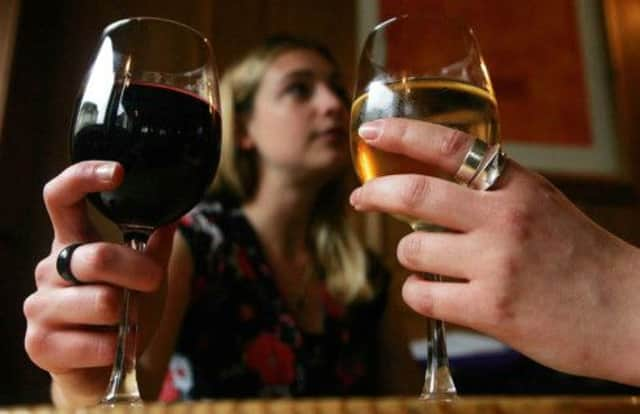Wine: The Santorini test


Making wine on an island might sound like an idyllic way of life, but it is never easy. On one of the wine world’s most fascinating islands, Santorini, in the south Aegean sea, water is so scarce they collect the morning dew.
The hot winds are so devastating they have to dig holes to shelter the vines. Now, with a thriving tourist industry, land prices have skyrocketed, threatening some of the island’s age-old pre-phylloxera vines.
Advertisement
Hide AdAdvertisement
Hide AdAnyone who has been to Santorini will know it as a beautiful, volcanic island famous for its red, black and white beaches. Arriving by cruise ship, ferry or plane and holidaying by the coast, you might be unaware that there are no rivers at all on the island – and every drop of rain that falls (rarely in summer) is collected.
Despite being a hot, dry land, vines on this unique Cyclade island, 200km south east of Greece’s mainland, have adapted well with the locals’ special viticultural training system. Post-and-wire vine trellising would not last long here. Vines in Santorini’s 1,400 hectares of vineyards are all planted wide apart – and cleverly coiled low to the ground into spiralling vine baskets with grapes hanging inside to protect them from the hot blasts of sandy wind and to make the most of that essential morning dew moisture.
With well-drained volcanic soils, vines have proved resistant to the devastating phylloxera louse. The volcanic soils give fabulous minerality to its wines and the ‘aspa’ volcanic ash also adds iodide salty aromas. Yields here are low, struggling to reach two tonnes per hectare – and no machinery can be used, so the wines are not cheap as it all has to be done by hand or using donkeys.
Santorini is also proving an ideal place for organic production – not just grapes – but other vegetables the island is so famous for, particularly sweet tomatoes, eggplants and cucumbers.
The island was an active volcanic region three to four million years ago, but it was a devastating earthquake in 1956 that destroyed vineyards, with many small wine producers leaving for the mainland. Since then, much of its plantings have been centred in the more sheltered south of the island, with wine production dominated by the Santo Wine co-operative.
Santorini has been hitting the headlines for its dry whites made by new boutique producers from ancient, rare, indigenous white grapes: assyrtiko, athiri and aidani. A little red mantilaria and mavrotragano are also grown here. However, in the old days, it was the sweet wines that attracted sailors to stop at the Cyclades’ most southerly island.
Producers making this sweet vin santo (holy wine) today, still use traditional methods of sun-drying grapes for 15 days, with a minimum of two years’ oak maturation.
Out of the island’s dozen producers operating today, the most exciting are small family wineries like Sigalas, Argyros and Hatzidakis – all of whom now sell to UK supermarkets and merchants.
Advertisement
Hide AdAdvertisement
Hide AdArgyros is the one of the oldest, founded in 1903, which owns just 35 hectares – but their Atlantis wine range is now available in Marks & Spencer. Sigalas, founded in 1991, on the Oia plain, make interesting reds (see below). However, my current favourite producer is Hatzidakis, founded in 1997, which make the best dry whites and dessert wine on the island.
Haridimos and Konstantina Hatzidakis’s family have always owned vineyards on the island, mainly at Pyrgos Kallistri. After the 1956 earthquake, their parents left for the mainland and vineyards were neglected. The new generation of the Hatzidakis family are now focusing on reviving age-old techniques and introducing organic viticulture with great success.
If you are planning a trip to this island, visitors can now enjoy the new Santorini wine route which weaves its way through the vineyards of this dormant volcano.
SANTORINI TASTE TEST
Dry White
ATLANTIS 2011 Argyros
£10.49, Marks & Spencer
Shrill acidity and citric fruit notes make this an unusual aperitif: made from all three white grapes, with assyrtiko dominant (95 per cent) and the remainder from aidani and athiri.
ASSYRTIKO 2012 Hatzidakis
£9.95-£13.75, The Wine Society; Waitrose; Oddbins
The clear winner in our taste test for its strong citric scents, very dry, salty notes and vivid minerally undertones. An all-round palate pleaser for those who like crisp, but full, dry whites.
AIDANI ORGANIC 2012 Hatzidakis
£16, Les Caves de Pyrene and L’Art du Vin, Dunfermline; www.lescaves.co.uk; www.aduv.co.uk
Made solely from the aidani grape using natural winemaking techniques – this produces dense, pithy, mouthwatering minerality with a salty undertone: delicious served with salty cheeses.
CUVEE No 15 ASSYRTIKO ORGANIC 2011 Hatzidakis
£21.95, www.lescaves.co.uk; www.formulawine.co.uk
Full intense wonderful depth of fruit – for the seasoned Santorini drinker it makes a perfect foil with grilled seafood.
Red
MAVROTRAGANO 2010 Sigalas
£26.95, Berry Bros & Rudd, www.bbr.com
Advertisement
Hide AdAdvertisement
Hide AdExpensive, but intriguing Santorini red with cherry fruit ripeness with prominent tannic finish – might well appeal to barolo lovers.
Sweet White
VIN SANTO 2003 Hatzidakis
£22 hf bt, Berry Bros & Rudd, www.bbr.com
An astonishing wine with caramel, honey, raisined notes – deep, dense and complex. Made from 80 per cent assyrtiko and 20 per cent aidani grape blend. Santorini’s nectar. Alcohol: 13 per cent.
Join Rose’s Island Wine Tasting at 28 Queen Street, Edinburgh, Wednesday 18 September, £35, [email protected]